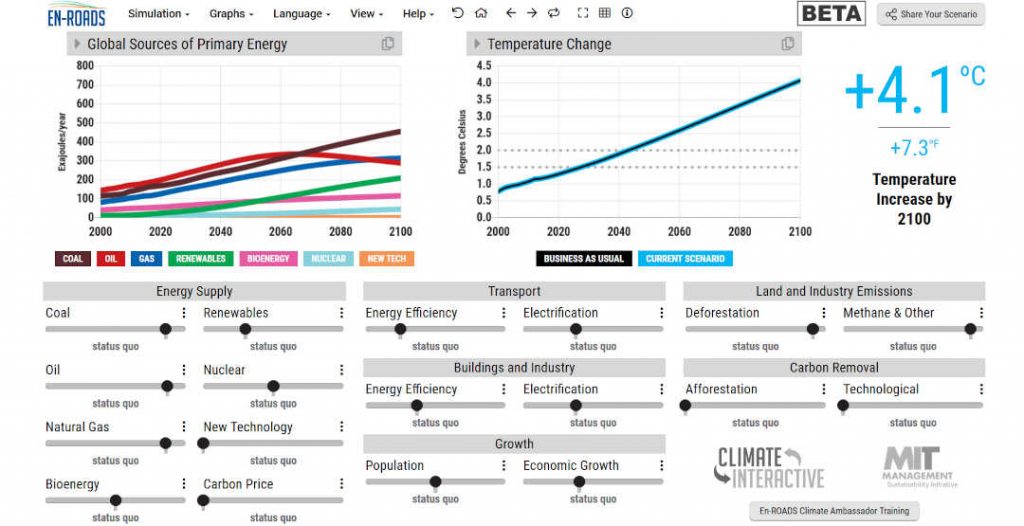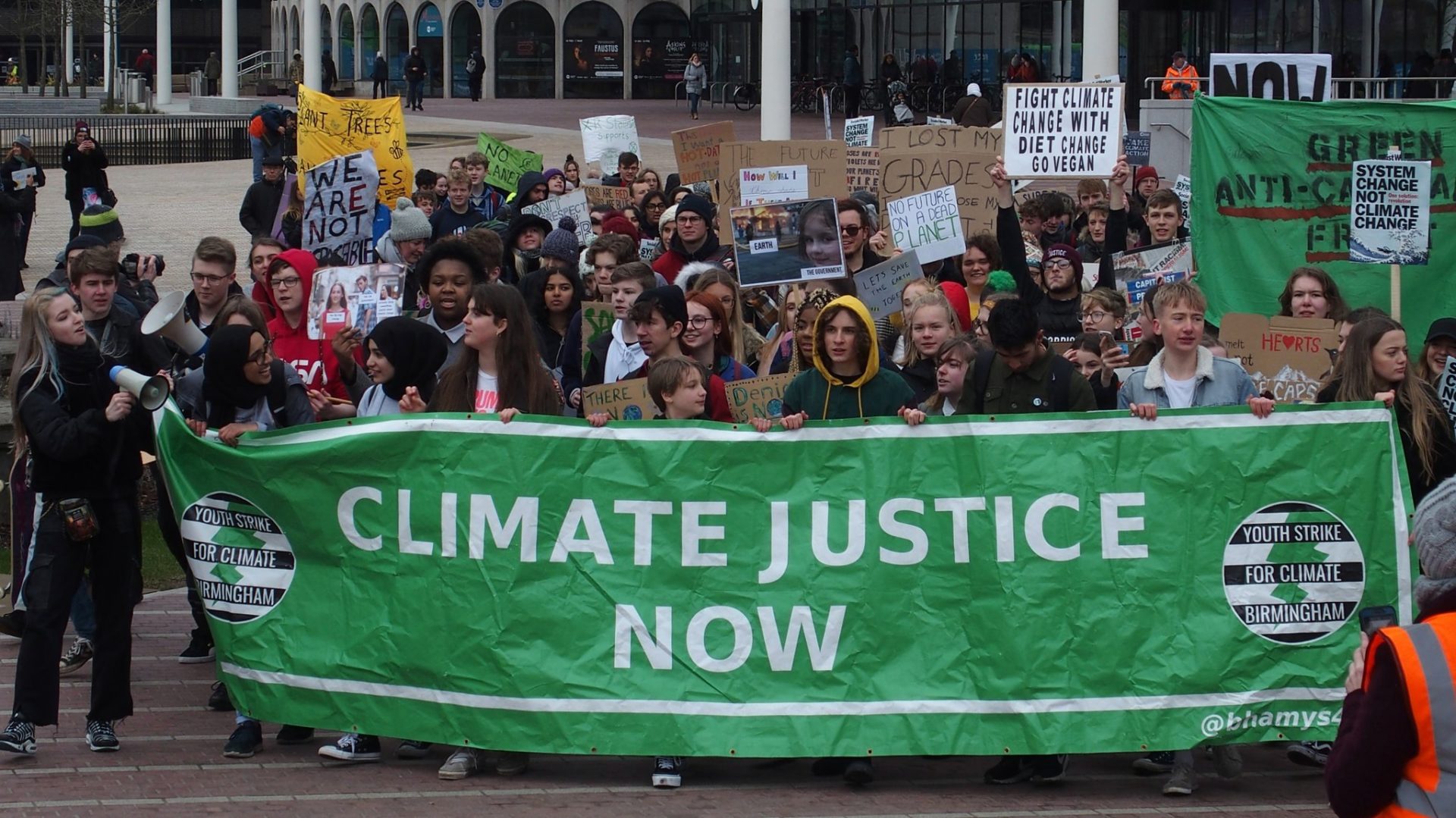Written by; Patrick Lincoln and Matthew Gahan
We know that we are in the midst of a climate and ecological emergency. A key question is what can we do about this? Which actions will have the greatest positive impact? Scientists have been working to develop modeling tools to help us to predict this and to inform policy decisions. One promising tool is EN-ROADS (Energy rapid overview and decision support).
EN-ROADS is a modeling tool developed with MIT Sloan, the not for profit organisation Climate Interactive, and Ventana Systems. It is best described as a Climate Change Solutions Simulator.
Background
The origins of this project date back over a decade and were born out of the fields of study known as Systems Dynamics and Systems Management. Dennis Meadows, a fellow of MIT Sloan, was a pioneer in these fields in the 1970’s and lead the team responsible for Limits to Growth report developed for Club of Rome think tank in 1972. Seeing the need for a policy led management approach to human induced impacts on the climate, MIT Sloan school researchers gathered together approximately 14,000 mathematical equations tested against the (IPCC) Intergovernmental Panel on Climate Change climate models in a rigorous peer reviewed process. The result of this effort was the En-Roads simulator and its brother C-Roads.
Applications
These tools were intended to provide educators, politicians, policymakers of all levels, and indeed the general public, with the ability to see the impact of changes in human behavior on the critical outcomes for the climate. It is currently being used by the UN Secretary-General’s office, members of the U.S. Congress, and a wide audience ranging from university professors to local community groups.
The program can be used to calculate the expected climate impacts stemming from a set of global policies that the user enters into the program. Essentially, the user can pretend that they are the dictator of the world and watch EN-ROADS calculate the climate impacts in terms of sea level rise, global average temperature increase, and ocean acidification among other impacts. EN-ROADS can also be used to determine the expected prices of energy, energy demand, land required for carbon sequestration among other variables.
The user can explore the impacts of changes to assumptions in the climate model. For example, if you want to change the climate sensitivity, the amount of global warming expected from a doubling of CO2 in the atmosphere, then you can change it to a value representing the high end of what the IPCC reports predicts it could be. You can use the program to see if it is reasonable to believe that there exists a global set of policies which can be used to meet the Paris Agreement given these circumstances. The program encourages the user to explore the impacts of these values and to test their own assumptions.
The program cannot be used to calculate expected damage to the economy and the potential loss of life from the impacts of temperature rise, so some expert analysis is required to understand potential real world outcomes. The global (GNP) Gross National Product and population size are treated as independent variables in the model, whereas in real life factors such as these are connected in complex ways. EN-ROADS allows for a broad selection of policies that can be implemented (see figure 1 below) and ideally, we don’t want our goal to be to reach a world where global GNP and population size are affected negatively by climate change.

Figure 1. Display of EN-ROADS as it is seen when the user hasn’t tinkered with any of the policies or assumptions. This is called the business as usual scenario. This is a highly undesirable outcome as according to the best scientific consensus we must keep the temperature increase to below 2 degrees centigrade to avoid the worst outcomes.
The Case For Modelling The Future.
The climate crisis is already upon us. If humanity had been wise enough to implement significant policies 25 years ago or even 15 years ago, then we could have coasted to a sustainable world by introducing a growing price on carbon along with a handful of other reasonable policies. As an example of this, consider that back in 2006 Jørgen Randers (one of the co-authors of Limits To Growth) headed a commission in Norway that came up with a 15-point plan to solve the climate crisis for Norway. The plan required that every Norwegian pay a mere €250 (£191) in extra taxes annually. If the plan had been given the green light, it would have allowed the country to cut its greenhouse gas emissions by two-thirds by 2050 and provide a case study other rich countries could learn from. Despite the cheap price tag, the proposal was rejected, because as Jørgen put it, “most voters preferred to use the money for other causes like yet another weekend trip to London or Sweden for shopping” [1].
We don’t have time to waste on pouring massive efforts into repeatedly finding solutions that get rejected and now the situation is much more difficult, EN-ROADS shows this to be the case. Many of our politicians and citizens don’t realize that solving the climate crisis this late in the game means that we have to pull on nearly every policy lever that is available to us. How are we supposed to get our politicians to realize this? How can we get them to agree on a global scale to pull on all of these policy levers? I don’t pretend to know the answers to these questions, but I know that the gargantuan task of calculating the expected results of a particular set of policies has been a road block to achieving the type of agreement that is needed, and EN-ROADS offers an obvious way to remove this road block, especially given its accessibility. The program has the additional benefit that the user can convince themselves that they discovered the solution to humanity’s problems. Humans have egos and we should be using that knowledge to our advantage. Politicians might not be willing to listen to the advice of experts because of their ego (as is the case with Donald Trump), but if they can convince themselves that they have found a way to save the world, then perhaps a new chapter of history can be written, a chapter where politicians treat the climate crisis as a crisis.
There are many actions we as individuals can take to prevent human caused climate change. I am asking for you the reader to consider doing the same as I am. The more of us there are out there bringing EN-ROADS to the public, the better our chances are of achieving a world consisting of politicians that are enlightened with respect to climate change.
I will end this article by quoting Greta in an attempt the reader to be motivated to act.
“Some people say that I should study to become a climate scientist so that I can solve the climate crisis. But the climate crisis has already been solved. We already have all the facts and solutions. All we have to do is to wake up and change.” Greta Thunberg at the Extinction Rebellion Rally in London on October 31rst, 2018. [2]
Sources:
[1] https://www.theguardian.com/sustainable-business/2015/jan/19/davos-climate-action-democracy-failure-jorgen-randers [2] https://www.environmentshow.com/greta-thunberg-quotes/ [3] https://en-roads.climateinteractive.org/scenario.html?v=2.7.29



